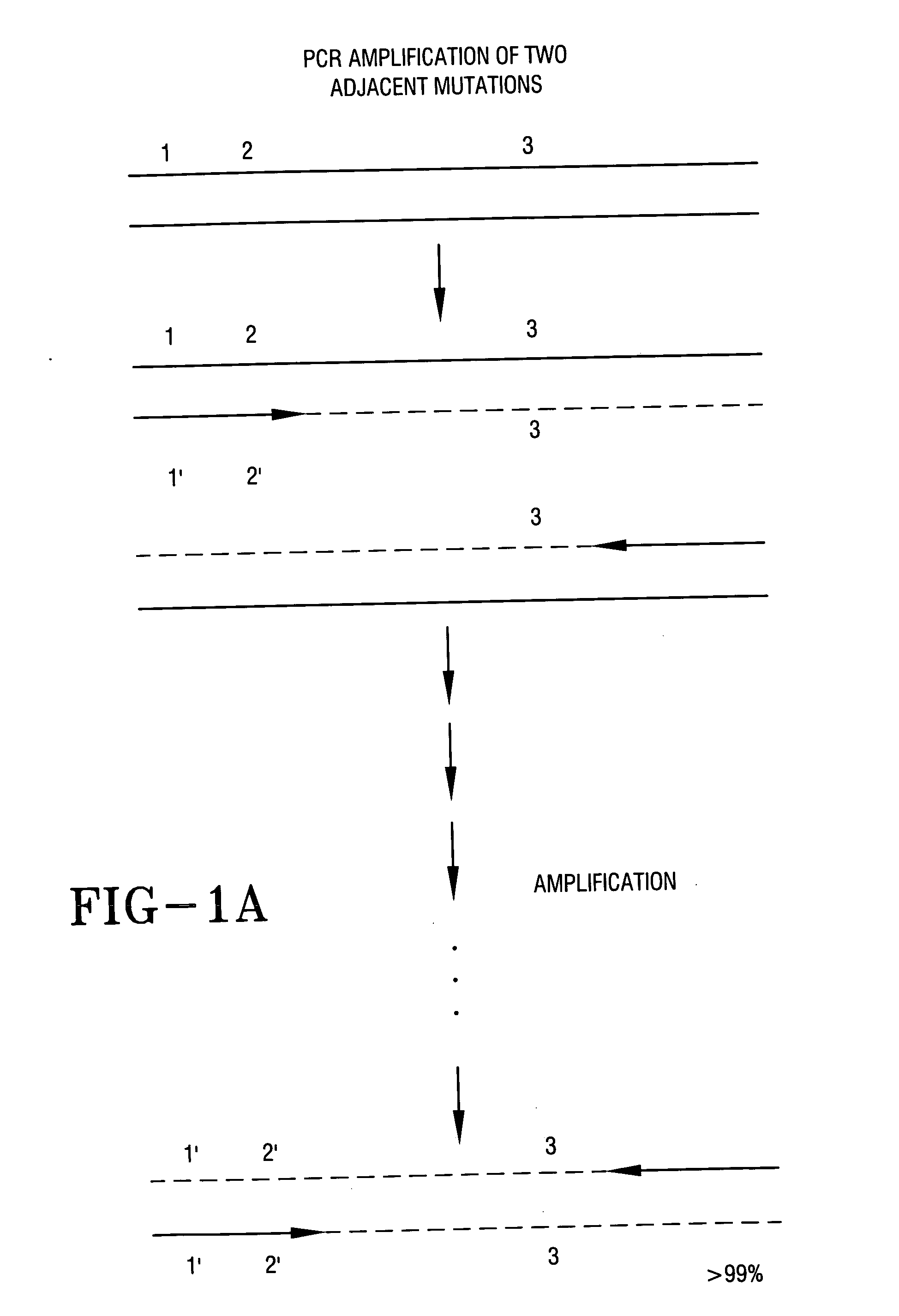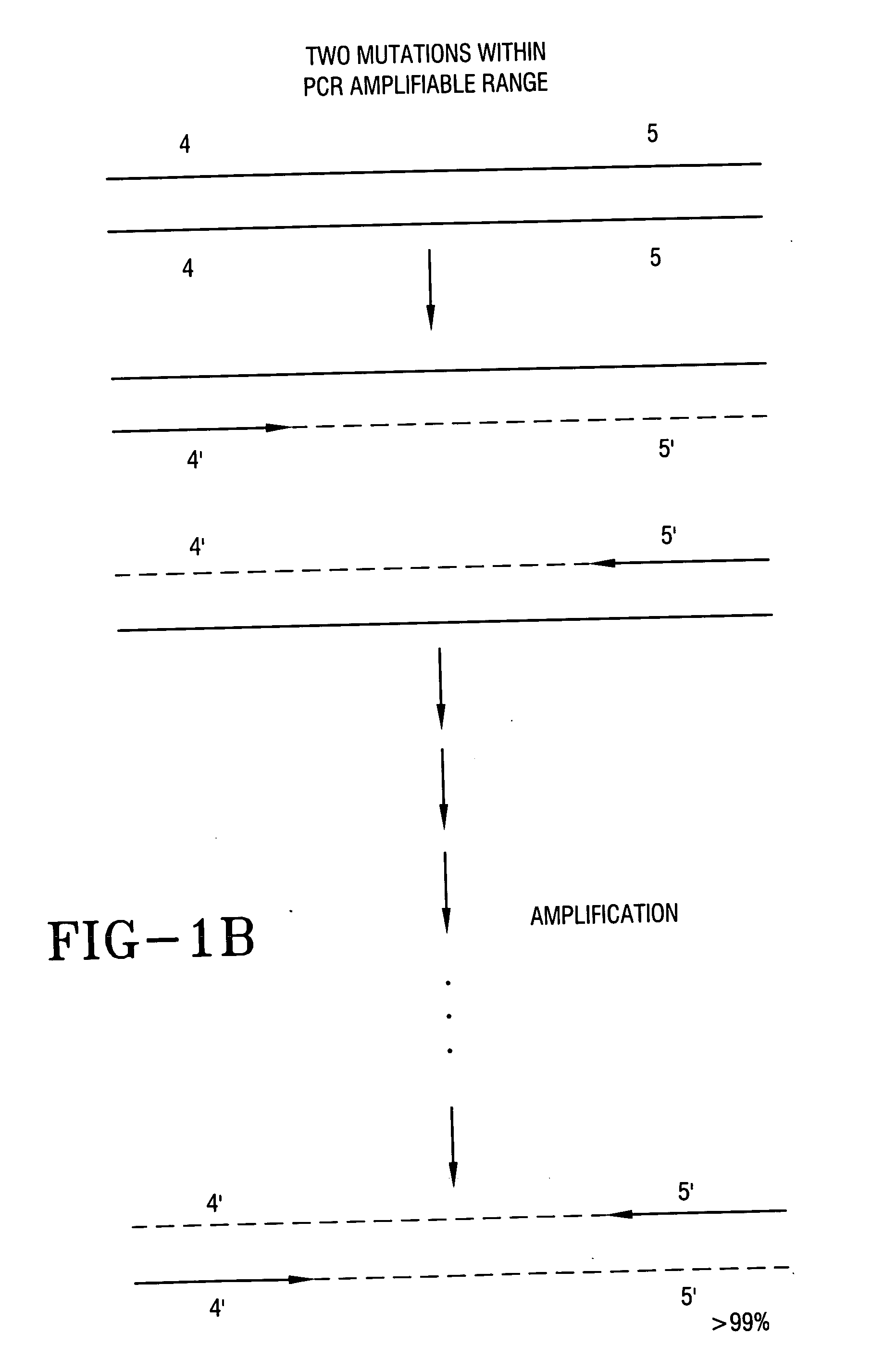Multiple controls for molecular genetic analyses
a technology of molecular genetic analysis and multiple controls, applied in the field of multiple controls for molecular genetic analysis, can solve problems such as reducing test reliability, and achieve the effect of reducing the stringency of the hybridization medium
- Summary
- Abstract
- Description
- Claims
- Application Information
AI Technical Summary
Benefits of technology
Problems solved by technology
Method used
Image
Examples
example i
PCR Amplification Constructs Immediately Adjacent Allelic Sequences
[0056] As shown in FIG. 1A, the sequences of two or more site-specific allelic nucleotide changes (1′ and 2′) can be synthesized directly into a single stranded DNA fragment that serves as an homologous PCR primer along with an homologous primer to the opposite strand spanning the downstream site. Even primers exceeding 60 basepairs long spanning more than one allelic site have served as unique PCR primers. The selected PCR primer pair can be used to amplify unique double stranded DNA products of a primer-defined length including normal and 1′ and 2′ nucleotide sequences using total DNA as an amplification template. Site 3 may represent one or more additional common allelic sequence(s) for which a different mutant allele is being prepared in a different segment. After multiple PCR amplification cycles,. >99% of double stranded amplified PCR products of the correct length will include allelic sites 1′, 2′ and 3. (Any...
example ii
PCR Amplification Constructs Two or More Site-Specific Alleles within a PCR Amplifiable Sequence Length
[0057] Referring to FIG. 1B, each of two individual primers of a complementary pair (4′ and 5′) can be synthesized to include one or more allelic sequences selected as a control. After multiple amplification cycles, >99% of the unique length double stranded fragments synthesized from this PCR primer pair will have both site-specific alleles. Any single primer may include two or more allelic nucleotide sequences within the single primer sequence. The minimum distance between two useful different allelic sequences in the same primer is determined by the DNA test method applied and the length and percentage of sequence homology in the DNA sequences that hybridize to the PCR product which together determine the melting temperature (Tm) required to denature hybridized double stranded DNA fragments. The specificity of hybridization and denaturation determines the reliability of the sele...
example iii
Splicing Together Two PCR Amplified Fragments Each with One or More Allele-specific Sites
[0058] Referring to FIG. 1C, fragments with two different allele-specific sites are ligated together to form a single unit that can serve as a control for both alleles. Nonspecific ligation like blunt ended ligation of two different fragments produces any one of four products. Any single site designation may represent two or more allele-specific sequences.
PUM
| Property | Measurement | Unit |
|---|---|---|
| nucleic acid sequence | aaaaa | aaaaa |
| nucleic acid | aaaaa | aaaaa |
| composition | aaaaa | aaaaa |
Abstract
Description
Claims
Application Information
 Login to View More
Login to View More - R&D
- Intellectual Property
- Life Sciences
- Materials
- Tech Scout
- Unparalleled Data Quality
- Higher Quality Content
- 60% Fewer Hallucinations
Browse by: Latest US Patents, China's latest patents, Technical Efficacy Thesaurus, Application Domain, Technology Topic, Popular Technical Reports.
© 2025 PatSnap. All rights reserved.Legal|Privacy policy|Modern Slavery Act Transparency Statement|Sitemap|About US| Contact US: help@patsnap.com



